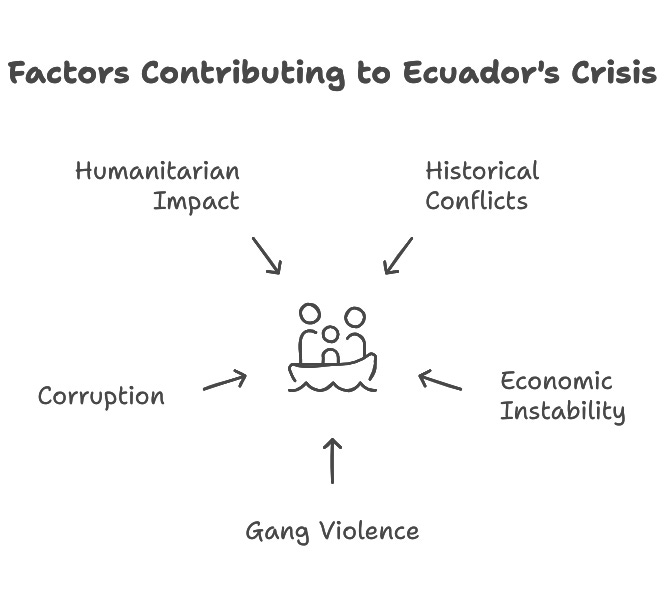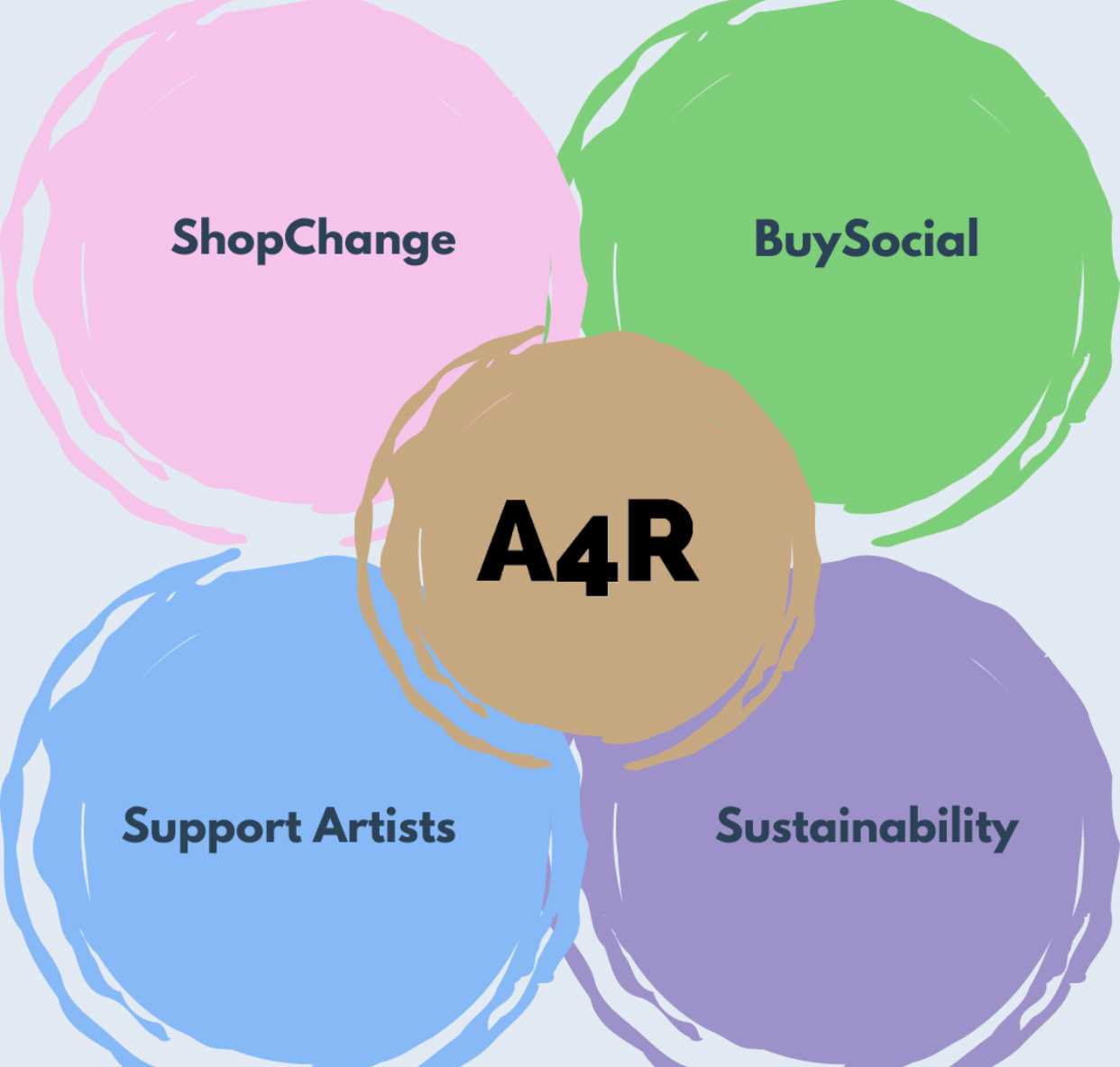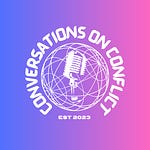From border wars to drug cartels: understanding Ecuador’s escalating crisis
Introduction:
Ecuador is now one of the world’s most violent countries, where crime, gangs and corruption are skyrocketing, once a paradisal tourist destination. It has a long history of conflict, financial instability, and political unrest, continuing after the three Ecuadorian-Peruvian Wars. Since January 2024, there have been large-scale attacks in response to the escape of two major gang leaders from prison, and President Daniel Noboa has declared a state of emergency and internal war. Ecuador is in a crisis that has affected its inhabitants and denied them fundamental human needs. What is the history of Ecuador and why is it so turbulent? What is happening there at the moment, and how is it affected by its past? What is it like for the people who live there?
Economic history: unstable
Ecuador, a South American country, is bordered by Colombia, Peru, and the Pacific Ocean, including the Galápagos Islands. Colonised by the Spanish Empire in the 16th century, it remained under its rule for nearly 300 years. It gained independence in 1822 and joined the confederation of Gran Colombia, but became a separate republic in 1830 due to tensions.
In the 20th century, Ecuador was one of the poorest countries in Latin America. By the late 1990s, around 45% of the population lived below the national poverty line. The discovery of oil in the Amazon region brought rapid economic growth and development to Ecuador, but it meant that its economy was dependent on it. The drop in oil prices in the 1980s and 90s marked the beginning of a financial crisis because oil composed 1/2 of the country’s exports and 1/3 of its revenue. This triggered the 1998–1999 Ecuador economic crisis, which resulted in a change in national currency, from the sucre to the dollar, in early 2000.
Military history: a battle with Peru
Ecuador has had internal conflict and military altercations with neighboring countries. This has led to conflicts with Peru over territorial disputes in the Amazon basin and Andes mountains. The major battles are the War of 1941, the Paquisha War (1981), and the Cenepa War (1995).
The War of 1941 (Spanish: Guerra del 41) was a disagreement over the Marañón River and border demarcation. It lasted for weeks and was resolved through the Protocol of Peace, Friendship, and Boundaries of Rio de Janeiro in 1942, mediated by the United States.
The Paquisha War took place in the Cordillera del Cóndor border region, rich in oil and resources. It lasted a few days in early 1981 until the Organization of American States (OAS) negotiated a ceasefire. A formal peace agreement was reached, the Rio Protocol of 1942, and both sides agreed to withdraw their troops to pre-conflict positions.
The Cenepa War was the most recent armed conflict between Ecuador and Peru, in early 1995, over the Cenepa River area. It began in January 1995 and lasted about a month. International mediation led to a ceasefire by the United States and Argentina.
Despite historical hostilities, both countries have worked towards diplomatic solutions for a stable relationship. However, Ecuador’s post-conflict environment has been anything but peaceful; there has been a surge in violent unrest associated with drug gangs.
What's happening in Ecuador?
Ecuador is experiencing uncontrollable violence and unrest due to gangs, drug trafficking, and corruption. The country's president has declared a 'state of emergency' due to recent events.
José Adolfo Macías Villamar, also known as ‘Fito’, the leader of the Los Choneros cartel and Ecuadorian drug trafficker, escaped from prison in Guayaquil on the 7th of January 2024. He was supposed to be transferred to a medium-security one. Two days later, Fabricio Colon Pico, leader of the Los Lobos gang, also escaped from prison in Riobamba. This triggered the following incident:
The Ecuadorian TV show TC was live in Guayaquil at 2pm on Januar20244, when masked Tiguerones gang members stormed the building, waving guns and explosives at the cameras and claiming to have bombs. They tied the journalists face down, put guns to their heads, and threatened everyone while gunshots resounded.
In response, Daniel Noboa announced that the country has entered an 'internal armed conflict’ and the government is officially ‘at war’ with the drug gangs. The president labeled twenty-two gangs as terrorist organizations and ordered the military to neutralize them.
Why did the raid happen? The primary reason is the role of prison in the drug gang operation. Corruption blurs the line between law enforcement and cartel leaders, as gangs are affiliated with the police, army, justice, and politicians. The drug money is expanding throughout Ecuador, and the cartel leaders control everything from prison, possible with the authorities' collusion. This raid on live television is a public display of their primacy over the government and authorities, manifesting the uncontrollable power of drug gangs in Ecuador.
What led to this?
As the global cocaine trade grows, Ecuador has become a mass drug distribution center due to its location between top coca producers Colombia and Peru. Ecuador's largest city, Guayaquil, is a major hub for trafficking in Latin America. In 2019, about 1/3 of Colombia’s cocaine went through this port, leading to a sudden increase in murders, with over half in Ecuador’s coastal provinces. The homicide rate has increased by over 500% since 2016, and more cocaine is transiting via Ecuador.
The rise in crime is also due to the Covid pandemic, which caused an economic crisis and boosted cocaine production. It benefits drug-trafficking businesses, as cartels can launder money more easily in Ecuador’s dollarized, cash-based, informal economy.
How does this affect the residents?
Host Katya Adler talks with Ecuadorian journalist Ana María Roura about the effects of the internal conflict in a podcast from The Global Story. Roura, who has been living in London for the past few years, is worried about her family in Ecuador due to security threats. They had to change routines to avoid narcotrafficking hubs and armed gang members. When Roura returned to Ecuador to cover the elections, she was struck by the emptiness of the usually bustling Calle Amazonas in Quito at 9pm.
Adler interviews her friend Marisol, whose daughter was kidnapped after work. Fortunately, her husband recognized her hat in the car and followed it. The kidnappers shot him, but realizing he was still behind, they let her out. Marisol’s reaction echoes the sentiment: ‘Where is our country going?’ This story is one of many displaying the violence and fear characterizing Ecuador today.
What does this mean from a human needs perspective?
Dr Kenneth Acha has devised a list of the seven fundamental human needs, which he believes are the ‘key to success in life’ and can be found here. These include safety/security and survival, understanding, and connection, needs obstructed by internal conflict in Ecuador.
The recent rise in crime and violence compromises the safety of its inhabitants, as civilians are caught between gangs and militia. There is growing uncertainty about the country's future, breaching the need for security that Dr. Acha proclaims.
Understanding is important because it includes education. Over 30% of the population lives in extreme poverty, lacking access to education, healthcare, food, and other basic necessities. Consequently, many young people lack employability skills and resort to joining drug gangs, perpetuating the cycle of narcotrafficking and violence.
Connection is a depleting human need in Ecuador due to drug wars, which has led to more people leaving the country and leaving behind friends and family. In 2023, a record 48,000 Ecuadorians crossed the Darién Gap, compared to 29,000 in 2022.
Ecuador is in a military, political, and financial crisis, under the control of violent drug gangs. This threatens the safety and security, connections, and access to basic necessities of its inhabitants.
In this episode Sasha discusses the post conflict region of Ecuador. She is a student journalist with us on a placement organised by the Oxford University Career Services. This article was edited using Lex.page. Image created with Napkin.Ai
Thank you for reading an A4R 🎨 Post. Don’t forget to visit our gift shop here. Every purchase scales our impact and pays our bills.














